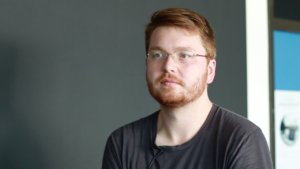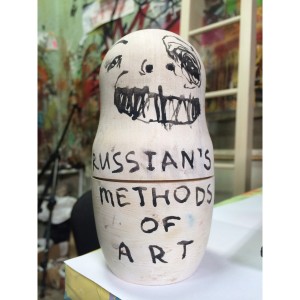So I became interested in the human body’s interaction with technology and then there is something really invasive like an implant versus something that’s completely on the exterior using EEG. These are at two opposite ends of the same spectrum. So it’s really interesting for me to be able to take out information rather than putting it into me, like you do with the internet, like you’re reading, or you’re watching TV, or putting it into you and to be able to output this information in an effortless way, you know, rather than writing, or painting and sculpting, or creating a website, the data is being pulled directly from my mind with a brain control interface, that’s the purpose of it.
This particular device is a consumer level brain control interface, so brain to computer interface, and what it does is it wirelessly transfers your EEG waves to a software algorithm that decodes them and then looks for patterns and so you can train your pattern, you can train the software to be able to understand your navigational movements. So if you are walking forward in your mind it’ll do that on a video game or with the cursor or it can be mapped to any number of key sequences so that you could have it open an application every time you think about moving forward, or it can have you walk in a video game.
What I ended up being interested in is seeing what I did while I was sleeping, because I’m not someone who sleepwalks, but I wanted to be able to experience what it would be like to sleepwalk. So I wore this while I was dreaming, and then left Google street-view open at my apartment and then I was able to wake up and play back through the video capture where I had walked around in the town based on the town based on my dream.
So that’s where these, these were the navigational movements mapped out as a physical blocks, so if I’m walking around this nothingness, and as I’m walking around kind of generating this shape, that indicates where I had traversed in the dream. So yeah, these paintings were the end result because it’s kind of, there are isometric drawings, so it’s this like 2D representation of something 3D. And that’s the same with the dream as it’s like this non real space that’s mimicking this real space.
And then the gallery installation at Transfer was the same thing. It was to take this non-space and create this physical object so the gallery was transformed to have the walls to make you have to walk around it and to kind of create the space that at the same time was inaccessible to the internet. I really tried to create a gallery in a way that it would be very difficult to photograph. Which made the documentation very difficult but that was the purpose of it. Because I’m also releasing an entire online version of this show that’s designed for the internet, you know? That is the same images but more interactive and more information and so I feel like internet is going to get more and than they could at the show. The show was very site specific as this you know, this large 18 foot wall sculpture you had to traverse around and you walk into the gallery you see nothing it’s like sleeping. You see nothing when someone is sleeping just a body on the bed and then you know, you walk around and its like entering into the brain and you get to see these different patterns happening and then you go to the back and there is the video of the actual motions occurring.
All this data that we are collecting isn’t giving us „us“ its just giving us this kind of outer negative space around us that we can help to use to understand us better, and so that’s what these were. You know a brain-computer-interface is something completely abstract and then to do this kind of a concept where I’m recording, it is so concept heavy and the way to introduce it to someone would be to just give him, here is an essay I wrote about it and that wasn’t enough, so I’ve written an essay about it, I created a panel about it, an online show about it and then a gallery show about and those helped to kind of quantify this concept in a way that no one of those things could have done, so…
Because there are eras where in order to have produced work as an artist you know, it wasn’t as free as it is now, where in order to can create work and not have to worry about patrons and gallery representation, or location on earth or being in a major metropolitan city, you can really produce it from anywhere so, we have those advantages. But I think that it’s hard to look at any one historical work in that sense. It is the oeuvre, the Gestalt of an artist practice…I don’t know. I wouldn’t say it’s necessarily like inaccurate to say sometimes a painting is just a painting…sometimes it was but that’s also, if the artist’s intention is to make it so, then it is. And I think that when you have works like Sol Le Witt or especially work that came out of the nineteen-hundreds, I mean there is so many new boundaries that were pushed, but I feel like they were sometimes pushed back to what they had originally been before the art institutions kind of came over and redefined this because I think there is some kind of a natural impulse to art making that gets a little bit high jacked by institutionalizing it and it’s not necessarily a bad thing, but it’s freeing when you find ways around it.
I feel like the speed has changed too, where it’s like you can produce, in order to flesh out a concept it may have taken years to produce the works that kind of go around it, or kind of create this series of work and now it’s kind of like, you have the opportunity to shoot this from different angles, or to produce it more quickly and especially with digital work, I mean, if you are quick as fast your fingers can go, you can generate the work. Yeah, I feel like because we are in an age of manufacturing, and it’s easy to have a print made and it’s easy to have a paintings produced if you are not a painter, it’s a much different rate. You know a lot of artists ship off their image to some Chinese warehouse then it just comes back as a painted image and they hang it in the gallery. Or print it down the street and come back so you can do these different manifestations much more quickly then maybe in the past. And I like to go back to craft like I really …like I mean it’s like those years of the Bauhaus where it’s like they focused on teaching us this history and the importance of craft and it’s kind of like that point of entry for me it’s like I really like to build things and so that’s where I get my enjoyment out of it.

















